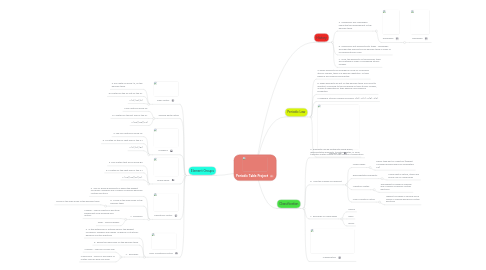
1. Element Groups
1.1. Alkali Metals
1.1.1. a. Any metal in group 1A, on the periodic table
1.1.2. b.Located on the far left on the P.T
1.1.3. c.(Li),(Na),(K)
1.2. Alkaline Earth Metals
1.2.1. a.Any metal in group 2A
1.2.2. b. Located on the left side of the P.T
1.2.3. c. (Be),(Mg),(Ca)
1.3. Halogens
1.3.1. a. The non-metals in group 7A
1.3.2. b. Located on the far right side of the P.T
1.3.3. c. (F),(Cl),(Br)
1.4. Noble Gases
1.4.1. a. Non-metals that are in group 8A
1.4.2. b. Located on the right side of the P.T
1.4.3. c. (He),(Ne),(Ar),(Kr).
1.5. Transitional Metals
1.5.1. a. One of group B elements in which the highest occupied s sublevel and a nearby d sublevel generally contain electrons
1.5.2. b. Found in the main body of the periodic table
1.5.2.1. Found in the main body of the periodic table
1.5.3. c. Examples
1.5.3.1. Copper - used in electrical electrical equipment such as wiring and motors
1.5.3.2. Silver - used in jewelry
1.6. Inner Transitional Metals
1.6.1. a. In the lanthanide or actinide series; the highest occupied s sublevel and nearby f sublevel of its atoms generally contain electrons
1.6.2. b. Below the main body on the periodic table
1.6.3. c. Examples
1.6.3.1. Uranium - used for nuclear fuel
1.6.3.2. Californium - used for discovery of metals such as gold and silver
2. History
2.1. a. Dobereiner and Mendeleev impacted the development of the periodic table
2.1.1. Dobereiner
2.1.1.1. Mendeleev
2.2. b. Dobereiner put elements into triads. Mendeleev arranged the elements in his periodic table in order of increasing atomic mass
2.3. c. Now, the elements on the periodic table are arranged in order of increasing atomic number
3. Periodic Law
3.1. a. When elements are arranged in order of increasing atomic number, there is a periodic repetition of their physical and chemical properties.
3.2. b. When elements are put on the periodic table from least to greatest, according to the increasing of their atomic number, as well as repeating of their physical and chemical properties.
3.3. c. Example: Atomic number increases: C(6)--N(7)--O(8)--F(9).
3.4. Periodic Law
4. Classification
4.1. a. Elements can be sorted into noble gases, representative elements, transition metals, or inner transition metals based on their electron configuration
4.2. b. How the classes are different
4.2.1. Noble Gases
4.2.1.1. Rarely take part in a reaction (highest occupied energy levels are completely full)
4.2.2. Representative Elements
4.2.2.1. Some exist in nature, others are found only in compounds
4.2.3. Transition Metals
4.2.3.1. The highest occupied s sublevel and a nearby d sublevel contain electrons
4.2.4. Inner Transition Metals
4.2.4.1. Highest occupied s sublevel and a nearby f sublevel generally contain electrons
4.3. c. Examples of noble gases
4.3.1. Helium
4.3.2. Neon
4.3.3. Argon

